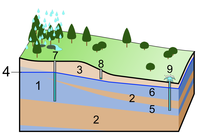
Photo from wikipedia
We present a method for risk assessment of groundwater drawdown induced land subsidence when planning for sub-surface infrastructure. Since groundwater drawdown and related subsidence can occur at large distances from… Click to show full abstract
We present a method for risk assessment of groundwater drawdown induced land subsidence when planning for sub-surface infrastructure. Since groundwater drawdown and related subsidence can occur at large distances from the points of inflow, the large spatial extent often implies heterogeneous geological conditions that cannot be described in complete detail. This calls for estimation of uncertainties in all components of the cause-effect chain with probabilistic methods. In this study, we couple four probabilistic methods into a comprehensive model for economic risk quantification: a geostatistical soil-stratification model, an inverse calibrated groundwater model, an elasto-plastic subsidence model, and a model describing the resulting damages and costs on individual buildings and constructions. Groundwater head measurements, hydraulic tests, statistical analyses of stratification and soil properties and an inventory of buildings are inputs to the models. In the coupled method, different design alternatives for risk reduction measures are evaluated. Integration of probabilities and damage costs result in an economic risk estimate for each alternative. Compared with the risk for a reference alternative, the best prior alternative is identified as the alternative with the highest expected net benefit. The results include spatial probabilistic risk estimates for each alternative where areas with significant risk are distinguished from low-risk areas. The efficiency and usefulness of this modelling approach as a tool for communication to stakeholders, decision support for prioritization of risk reducing measures, and identification of the need for further investigations and monitoring are demonstrated with a case study of a planned railway tunnel in Varberg, Sweden.
Journal Title: Stochastic Environmental Research and Risk Assessment
Year Published: 2019
Link to full text (if available)
Share on Social Media: Sign Up to like & get
recommendations!